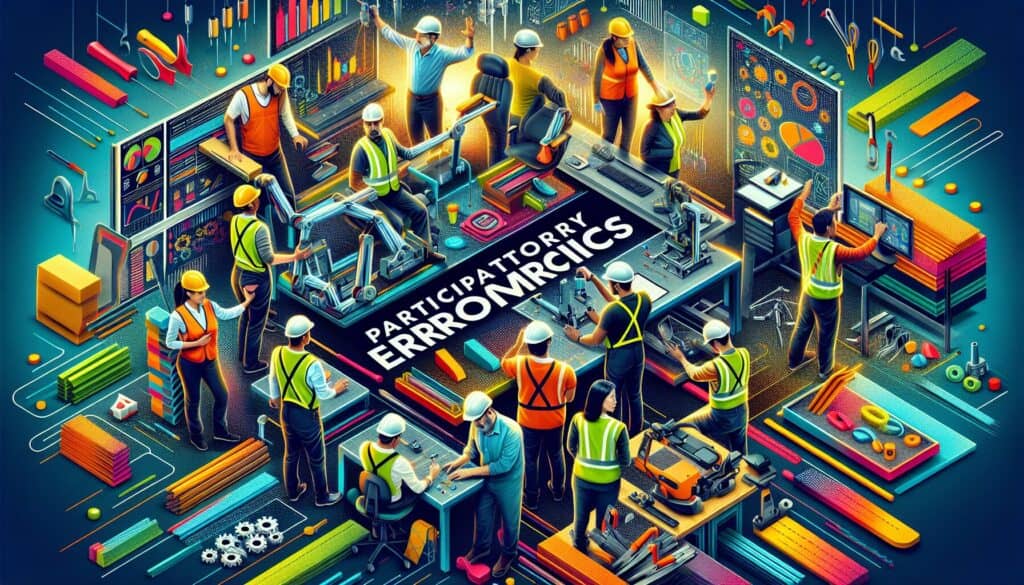Implicar activamente a los trabajadores en la identificación, el análisis y el control. ergonómico riesgos en su propio trabajo y entorno laboral.
- Metodologías: Ingeniería, Fabricación, Diseño de producto, Calidad, Gestión de riesgos
Ergonomía participativa (con aportaciones de los trabajadores)

Ergonomía participativa (con aportaciones de los trabajadores)
- Mejora continua, Ergonomía, Human Factors, Diseño centrado en el ser humano, Manufactura esbelta, Técnicas de resolución de problemas, Mejora de procesos, Trabajo en equipo, Diseño centrado en el usuario
Objetivo:
Cómo se utiliza:
- Forma equipos de trabajadores, supervisores y expertos en ergonomía para identificar colectivamente los problemas ergonómicos, aportar soluciones y aplicar y evaluar las mejoras.
Ventajas
- Aumenta la implicación de los trabajadores y su apropiación de las soluciones; utiliza el conocimiento directo de los trabajadores sobre sus tareas; a menudo conduce a soluciones más prácticas y sostenibles.
Contras
- Puede llevar mucho tiempo gestionar el proceso participativo; requiere formación para los trabajadores y la dirección; potencial de opiniones contradictorias o sugerencias poco realistas si no se facilita bien.
Categorías:
- Ergonomía, Fabricación, Calidad
Ideal para:
- Implicar directamente a los trabajadores en el proceso de identificación y resolución de problemas ergonómicos en sus puestos de trabajo.
Participatory Ergonomics is particularly beneficial in sectors such as manufacturing, healthcare, and office environments, where physical tasks and workspace layouts significantly impact worker safety and productivity. During the design phase of a new workspace or equipment, this methodology can be implemented effectively through workshops and brainstorming sessions involving a diverse team of employees who perform the tasks, supervisors who manage workflows, and ergonomics experts who understand the principles of optimal design. The collaboration among these participants not only allows for a comprehensive identification of ergonomic challenges but also encourages innovative solutions grounded in real-world applications. Various industries have successfully adopted this approach to enhance job satisfaction and productivity while reducing workplace injuries; for example, in manufacturing, workers can provide feedback on machinery layouts and tool accessibility, while in healthcare, nursing staff can identify challenges in lifting techniques or equipment placement that affects patient care. Engaging employees in this manner fosters a culture of continuous improvement as they become invested in the solutions they help create, making it more likely that changes will be implemented effectively and maintained over time. When teams regularly evaluate the changes made and solicit further input, an ongoing dialogue is established, promoting adaptability as tasks and technologies evolve. The success of these initiatives often leads organizations to establish permanent ergonomic committees or task forces that regularly assess workplace conditions and champion employee-driven improvements.
Pasos clave de esta metodología
- Identify ergonomic issues through interactive discussions with workers.
- Engage in brainstorming sessions to generate ideas for improvements.
- Prioritize identified solutions based on feasibility and impact.
- Develop action plans for implementing selected solutions collaboratively.
- Execute the action plans while involving workers in the process.
- Monitor and assess the impact of implemented solutions with worker feedback.
- Iterate on solutions based on evaluation results and ongoing worker input.
Consejos profesionales
- Conduct regular workshops that allow workers to voice concerns and suggest feasible ergonomic enhancements, fostering an ongoing dialogue around workplace safety.
- Utilize collaborative tools and visual aids like sketches or 3D models during brainstorming sessions to guide discussions toward tangible solutions.
- Establish metrics for evaluating ergonomic interventions, ensuring feedback loops are in place for continuous improvement based on real-world applications and user experiences.
Leer y comparar varias metodologías, recomendamos el
> Amplio repositorio de metodologías <
junto con otras más de 400 metodologías.
Sus comentarios sobre esta metodología o información adicional son bienvenidos en la dirección sección de comentarios ↓ , así como cualquier idea o enlace relacionado con la ingeniería.
Contexto histórico
1986
(si se desconoce la fecha o no es relevante, por ejemplo "mecánica de fluidos", se ofrece una estimación redondeada de su notable aparición)

Publicaciones relacionadas
Cuestionarios sobre molestias musculoesqueléticas
Pruebas multivariantes (MVT)
Análisis de regresión múltiple
Sistemas de captura de movimiento
Método MoSCoW
Prueba de la mediana de Mood